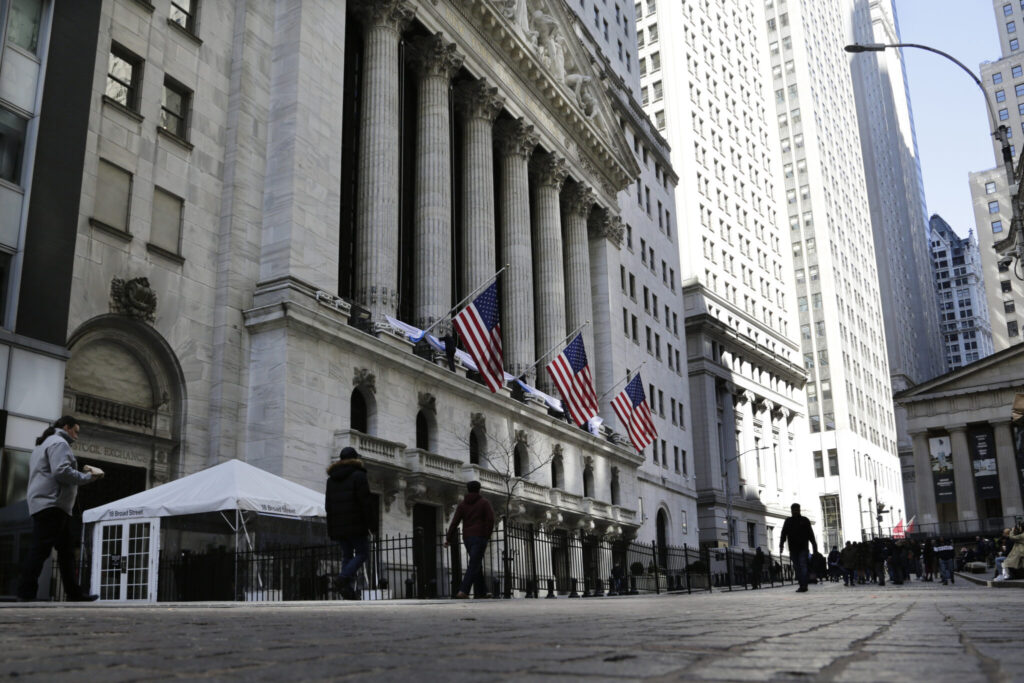The tech-heavy Nasdaq led Wall Street gains on Thursday as Nvidia shares soared on a blowout forecast that also lifted other AI-related companies, while investors watched for signs of progress in U.S. debt ceiling talks. Shares of Nvidia Corp (NVDA.O), the world’s most valuable listed chip company, jumped 25.5% to hit a record high, after it forecast quarterly revenue 50% higher than Wall Street estimates and said it was ramping up supply to meet demand for its artificial-intelligence chips. The Associated Press has the story:
AI pulls Wall St. higher despite DC debt woes
Newslooks- NEW YORK (AP)
A monster financial forecast from one of Wall Street’s most influential stocks is helping to support the market Thursday, as worries worsen about political rancor in Washington.
The S&P 500 was 0.4% higher in early trading after chipmaker Nvidia reported stronger profit and revenue than expected for the latest quarter, benefiting from the tech world’s rush into artificial intelligence. It helped the Nasdaq composite leap 1.3%, as of 9:40 a.m., while the Dow Jones Industrial Average was down 111 points, or 0.3%, at 32,688.
Because it’s one of Wall Street’s most valuable stocks, Nvidia’s 22.5% surge was the strongest force pushing upward on the S&P 500. Its forecast of roughly $11 billion in revenue for the current quarter blew past analysts’ expectations for less than $7.2 billion. Nvidia’s stock has already more than doubled this year.
Stocks of other chip makers also charged higher after Nvidia described a race by its customers to put AI “into every product, service and business process.” Advanced Micro Devices gained 7.7%.
Big Tech stocks rallied further, adding to recent gains fueled by excitement about AI. Google’s parent company, Alphabet, rose 2.5%, while Microsoft gained 2.5%.
They helped solidify the market despite worries about the U.S. government edging closer to a possible default on its debt. Washington could run out of cash to pay its bills as soon as June 1, unless Congress allows it to borrow more.
The widespread expectation on Wall Street has been for Washington to eventually come to a deal, as it has many times before, because a failure would likely be awful for the entire economy. But the bitter partisanship on Capitol Hill is hurting faith and trust in the government.
Fitch said late Wednesday that it could downgrade the U.S. government’s “AAA” credit rating. It said it still expects a resolution before the U.S. Treasury runs out of cash, but it sees the risk of a mistake having risen.
“The brinkmanship over the debt ceiling, failure of the U.S. authorities to meaningfully tackle medium-term fiscal challenges that will lead to rising budget deficits and a growing debt burden signal downside risks to U.S. creditworthiness,” Fitch said.
In 2011, Standard & Poor’s cut its “AAA” credit rating for the United States following a similar political squabble about the debt limit.
Another concern rests on exactly when the “X-date” deadline will hit for the U.S. Treasury to run out of cash.
While Isaac Boltansky, BTIG director of policy research, said he sees an 11th hour deal happening, “Washington is still arguing over exactly when midnight hits, which remains our primary concern as deadlines are the only viable forcing mechanism in town.”
The majority of stocks on Wall Street were falling, including a 15.9% drop for Dollar Tree. The retailer reported weaker profit for the latest quarter than analysts expected.
In the bond market, yields rallied after reports suggested the economy is in stronger shape than feared.
One said that fewer workers applied for unemployment benefits last week than expected. That’s a signal that the job market remains remarkably solid despite much higher interest rates meant to slow inflation.
Another report estimated the U.S. economy grew at a 1.3% annual pace in the first three months of the year, stronger than the 1.1% earlier thought. That report also suggested inflation was a touch hotter during the start of 2023 than earlier thought.
The stronger-than-expected data allays fears that have built on Wall Street about a coming recession. But it also pushed traders to increase some bets for the Federal Reserve to raise interest rates again next month. Traders are split on whether the Fed could take a pause in June after hiking rates at a furious pace for more than a year.
Higher rates have helped inflation to slow from its peak last summer, but they do that by slowing the entire economy and dragging on prices for stocks, bonds and other investments.
The yield on the two-year Treasury, which tends to track expectations for Fed action, jumped to 4.45% from 4.38% last Wednesday.
The 10-year yield rose to 3.76% from 3.74%. It helps set rates for mortgages and other important loans.
Stock markets abroad were mostly weaker, but the declines were milder than the prior day’s.
Germany’s DAX was down 0.1% after data showed its economy shrank in the first three months of the year, the second straight quarter that’s occurred.
Hong Kong’s Hang Seng fell 1.9% amid worries China’s economic recovery after the government relaxed pandemic restrictions late last year is losing steam. Stocks in Shanghai slipped 0.1%.







